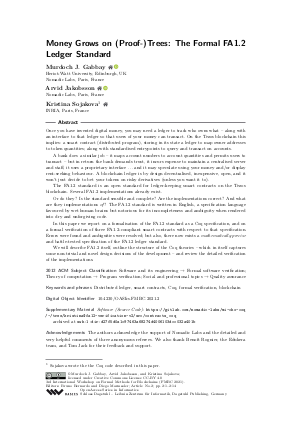@InProceedings{gabbay_et_al:OASIcs.FMBC.2021.2,
author = {Gabbay, Murdoch J. and Jakobsson, Arvid and Sojakova, Kristina},
title = {{Money Grows on (Proof-)Trees: The Formal FA1.2 Ledger Standard}},
booktitle = {3rd International Workshop on Formal Methods for Blockchains (FMBC 2021)},
pages = {2:1--2:14},
series = {Open Access Series in Informatics (OASIcs)},
ISBN = {978-3-95977-209-9},
ISSN = {2190-6807},
year = {2021},
volume = {95},
editor = {Bernardo, Bruno and Marmsoler, Diego},
publisher = {Schloss Dagstuhl -- Leibniz-Zentrum f{\"u}r Informatik},
address = {Dagstuhl, Germany},
URL = {https://drops-dev.dagstuhl.de/entities/document/10.4230/OASIcs.FMBC.2021.2},
URN = {urn:nbn:de:0030-drops-154267},
doi = {10.4230/OASIcs.FMBC.2021.2},
annote = {Keywords: Distributed ledger, smart contracts, Coq, formal verification, blockchain}
}

 Creative Commons Attribution 4.0 International license
Creative Commons Attribution 4.0 International license
